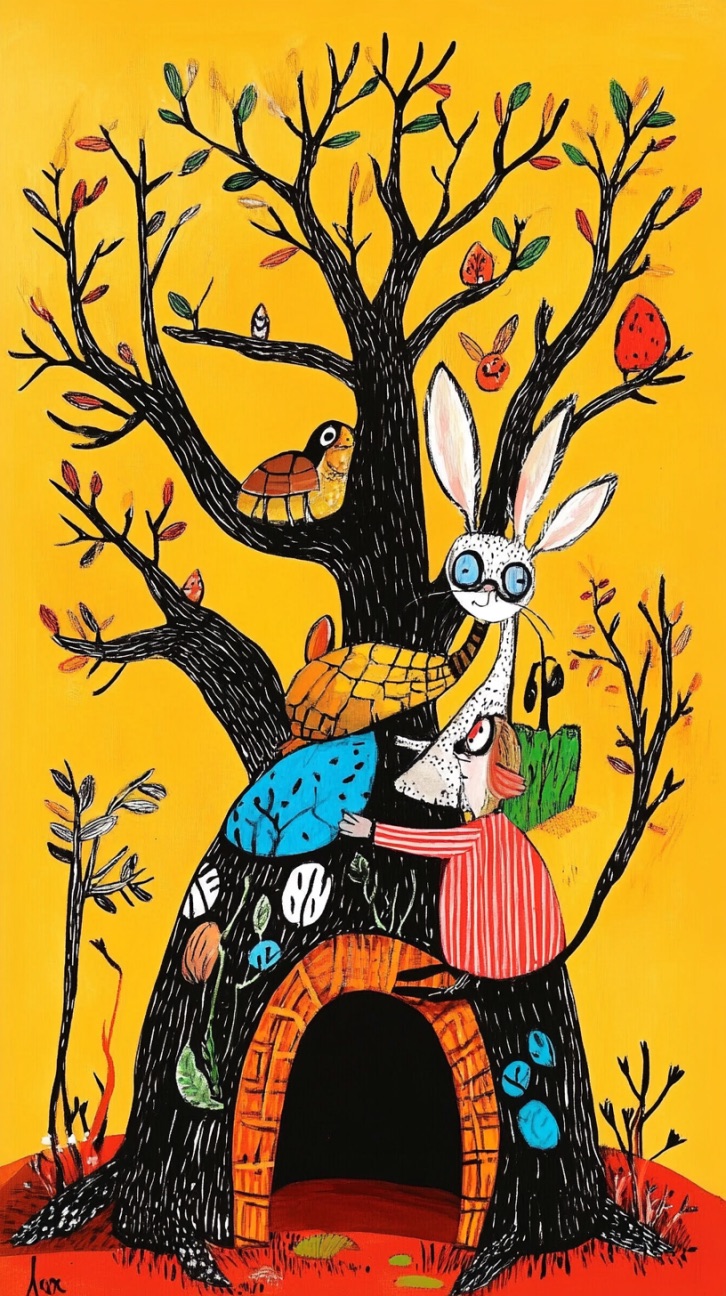At first glance, the vibrant painting of a whimsical tree adorned with a rabbit, a tortoise, and a host of colorful elements seems like an abstract explosion of imagination. Yet, hidden within its vibrant brushstrokes lies a reimagined essence of Aesop’s timeless fable, “The Tortoise and the Hare.” This artwork invites us to see beyond the literal and delve into the art of abstraction—a medium that bridges traditional storytelling with modern visual interpretation.
Abstraction as a Storytelling Tool
Abstract art, with its departure from realism, creates space for interpretation, allowing viewers to form personal connections with the imagery. In this piece, the tortoise, perched steadily on the branches, contrasts with the energetic yet inquisitive hare wearing glasses—a quirky representation of intellect and observation. The bright yellow background, filled with scattered fruits and leaves, symbolizes vitality, growth, and the unpredictable twists of life. It distills the essence of Aesop’s fable into a single image, without the need for words.
The story of the tortoise and the hare is not depicted literally but abstracted into a tableau of colors, forms, and ideas. The tree, a central element, represents life’s journey—its twists and turns, its ups and downs. The open door at the tree’s base hints at the starting point of their race, while the interwoven branches signify their intertwined paths.
A New Interpretation
In this reinterpretation, the hare is no longer a symbol of overconfidence but rather curiosity and adaptability. Its glasses suggest the importance of learning from past mistakes and seeing the world with clarity. The tortoise, meanwhile, is a reminder of the virtues of steadiness and perseverance. Together, they tell a modernized version of the fable: success isn’t a race against others but a journey of self-awareness and balance.
The abstract style transforms the story’s moral lessons into a visual language. Each viewer may draw different conclusions—some may see the playful interaction of opposites, while others might interpret the scene as a commentary on patience versus impulsiveness in a fast-paced world.
The Role of Abstraction in Modern Art
Abstraction enables artists to move beyond narrative constraints, creating a platform where stories become universally relatable. In the context of Aesop’s fables, abstraction breathes new life into old tales, blending simplicity with complexity, whimsy with depth. This painting doesn’t just depict a story—it invites viewers to think, question, and engage with the lessons in a way that’s uniquely their own.
Through abstraction, artists build bridges between traditional storytelling and contemporary culture. They transform age-old parables into timeless messages that resonate with modern audiences, whether through a burst of vibrant colors or the deliberate placement of surreal elements.
Conclusion: Finding the Story Within the Brushstrokes
This artwork reminds us that stories don’t always have to be spelled out—they can be felt, interpreted, and rediscovered. Just as the tortoise and the hare embarked on a race with different approaches, so too does abstract art challenge viewers to embark on their own journey of interpretation.
The art of abstraction is about finding beauty in complexity and simplicity alike. It turns even the most familiar tales into new adventures, proving that the boundaries of storytelling and creativity are limited only by our imagination.
Youtube 👆
